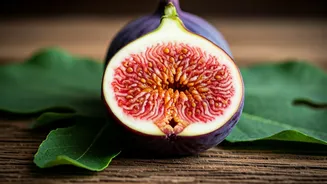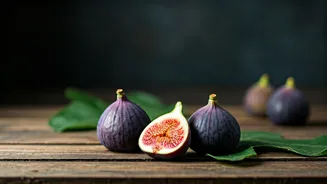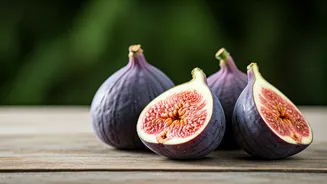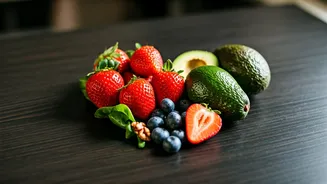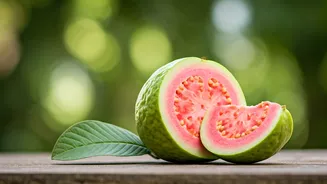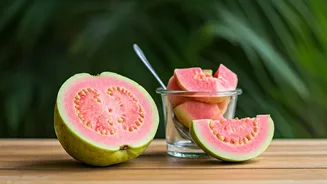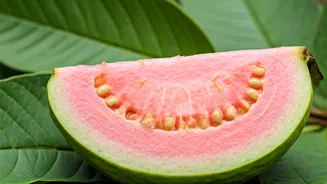Fig's Digestive Boost
Figs are a fantastic source of fiber, an essential nutrient for maintaining a healthy digestive system. Dietary fiber adds bulk to the stool, helping to prevent
constipation and promote regular bowel movements. This contributes to a healthier gut environment. By including figs in your diet, you're giving your body a natural nudge towards better digestion. Fiber also aids in the efficient absorption of nutrients from the food you consume. The fiber in figs helps regulate blood sugar levels, preventing spikes after meals. Studies show that a high-fiber diet can reduce the risk of digestive issues, such as diverticulitis and irritable bowel syndrome. Enjoying figs regularly can contribute to a happier and healthier digestive system, supporting overall well-being.
Heart-Healthy Figs
Figs are packed with nutrients that support heart health. They contain antioxidants, which combat free radicals that can damage cells and contribute to heart disease. These antioxidants also help to reduce inflammation in the body. Furthermore, figs are a good source of potassium, a mineral that helps regulate blood pressure. High blood pressure is a major risk factor for heart disease, and potassium helps to counteract its effects. Eating foods like figs, rich in potassium, can assist in maintaining healthy blood pressure levels. Figs also provide soluble fiber, which can help lower cholesterol levels. By incorporating figs into your diet, you are giving your heart essential nutrients that support its functions and minimize the risk of heart-related issues. Studies show that regular consumption of figs can lower the risk of cardiovascular diseases.
Fig Recipes: Breakfasts
Start your day with figs in creative ways! First, try adding sliced figs to your oatmeal or yogurt, along with a sprinkle of nuts and seeds for extra texture and nutrients. This provides a delightful sweetness and a boost of fiber. Next, make a fig smoothie with figs, banana, spinach, and almond milk for a quick and nutritious breakfast. The natural sugars in the figs will satisfy your sweet tooth without the need for processed sugars. Another delicious option is fig and ricotta toast, made with whole-wheat bread, creamy ricotta cheese, and fresh fig slices drizzled with honey. This offers a balance of protein, healthy fats, and fiber. Lastly, consider fig pancakes. Simply add diced figs to your pancake batter and enjoy the sweet surprise of figs in every bite. Figs offer a versatile way to make your morning meal more exciting and more beneficial for your health.
Fig Recipes: Snacks
Figs are perfect for satisfying those mid-day cravings! First, grab a handful of dried figs, a convenient and delicious snack. The chewy texture and natural sweetness make them an ideal alternative to processed snacks. Pair dried figs with a small serving of nuts or seeds for added protein and healthy fats. Another option is fig and cheese skewers. Combine fig slices with cubes of cheese and a drizzle of balsamic glaze for a flavorful treat. For a more savory option, consider fig and prosciutto bites. Wrap fig slices with prosciutto for a combination of sweet, salty, and satisfying flavors. Fig energy balls are also a great snack choice. Blend figs with nuts, seeds, and dates, and roll them into bite-sized balls for an on-the-go energy boost. Enjoy these easy ways to enjoy figs as tasty snacks and keep you feeling full and energized throughout the day.
Fig Recipes: Salads
Figs can transform your salads! Create a fresh fig and arugula salad with crumbled goat cheese, toasted walnuts, and a light vinaigrette. The sweet figs pair perfectly with the peppery arugula and creamy goat cheese. Alternatively, add sliced figs to a mixed green salad with grilled chicken or chickpeas for a more substantial meal. This adds natural sweetness and boosts fiber and nutrients. Another idea is a fig and spinach salad with pecans and a balsamic dressing. The spinach provides vitamins and minerals, while the figs add sweetness. For a Mediterranean-inspired salad, combine figs with olives, feta cheese, and a lemon-herb dressing. This is a delightful combination that offers multiple flavors and textures. Figs offer an array of salad possibilities, enhancing flavor and nutritional value. They can truly elevate simple ingredients to create a delicious and satisfying dish.
Fig Recipes: Main Dishes
Figs can add a touch of sweetness to your main meals! Try a fig-glazed chicken or pork. The sweetness of the figs complements the savory flavors of meat. For a vegetarian option, consider a fig and lentil stew. The figs add sweetness and depth to the hearty stew. Another great dish is fig and prosciutto pizza. The combination of sweet figs, salty prosciutto, and melted cheese creates a flavor explosion. You can also make a fig and goat cheese tart, using a puff pastry crust and topped with figs, goat cheese, and a drizzle of honey. This is both elegant and delicious. Finally, create a fig and balsamic reduction sauce to drizzle over roasted vegetables or grilled meats. These recipe ideas can easily be integrated into your usual main courses.
Fig Recipes: Desserts
Figs shine in the world of desserts! Create a fig and almond crumble, using fresh or dried figs with a buttery crumble topping. The sweetness of the figs is balanced by the crunchy topping. Another simple option is baked figs with honey and a sprinkle of cinnamon. The roasting process enhances the natural sweetness of the figs. Make a fig and walnut cake or bread pudding. The figs add moisture and sweetness to the cake. Or try a fig ice cream or sorbet. Puree figs with other ingredients for a refreshing treat. Finally, create a fig and chocolate tart, pairing the sweetness of figs with the richness of chocolate. Figs enhance the flavor and elevate desserts, giving them unique textures and flavors. These fig-based desserts are a great way to end your meal on a sweet note.
Fig Puree and Preserves
Figs can be preserved and enjoyed throughout the year. Make a fig puree by blending fresh or cooked figs until smooth, perfect for spreading on toast or adding to smoothies. Prepare fig preserves by simmering figs with sugar and a little lemon juice until thickened. This preserves the figs and concentrates their flavor. Alternatively, create a fig jam, which is similar to preserves but has a chunkier texture. You can enjoy fig preserves and jam with toast, crackers, or as a condiment. You can also use fig puree in baked goods, such as cakes, muffins, and bread. Making fig puree, preserves, or jam is a great way to reduce food waste. These recipes help you to extend the enjoyment of figs beyond the fresh fig season.
Fig's Nutritional Boost
Figs are an excellent source of essential nutrients. They are rich in fiber, which supports healthy digestion, and in various vitamins and minerals. Figs are a good source of potassium, which helps regulate blood pressure, and are packed with antioxidants, which combat free radicals. Consuming figs provides a natural sweetness without added sugars. They are also low in fat and calories, making them a suitable addition to a balanced diet. Figs are also a source of calcium, magnesium, and other essential nutrients, supporting overall health and well-being. These nutrients work together to support a healthy body, keeping it running efficiently. By including figs in your meals, you can increase your intake of these valuable nutrients and enjoy the health benefits that figs offer.
Buying and Storing Figs
Selecting and storing figs properly will maximize their flavor and lifespan. When choosing fresh figs, look for ripe ones that are soft to the touch and slightly fragrant. Avoid figs that are bruised or damaged. The color of the fig may vary, but they should have a vibrant appearance. Once home, store fresh figs in the refrigerator for up to a few days. Place them in a single layer to avoid bruising. Dried figs can be stored in an airtight container at room temperature for several months. Ensure the container is kept in a cool, dark, and dry place. Proper storage helps to maintain the quality and flavor of figs. Enjoy fresh figs quickly, as they are at their best when they are fully ripe. Dried figs are a convenient option. By handling and storing figs correctly, you can guarantee their deliciousness and extend their use.
